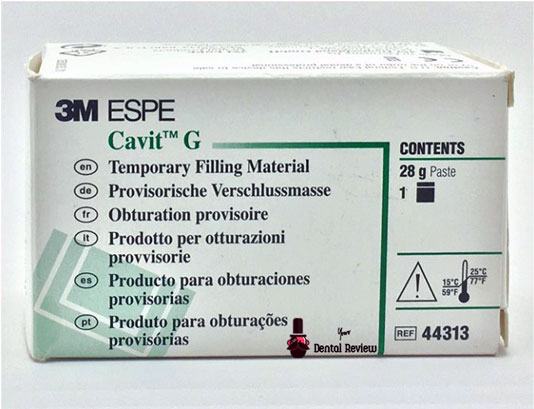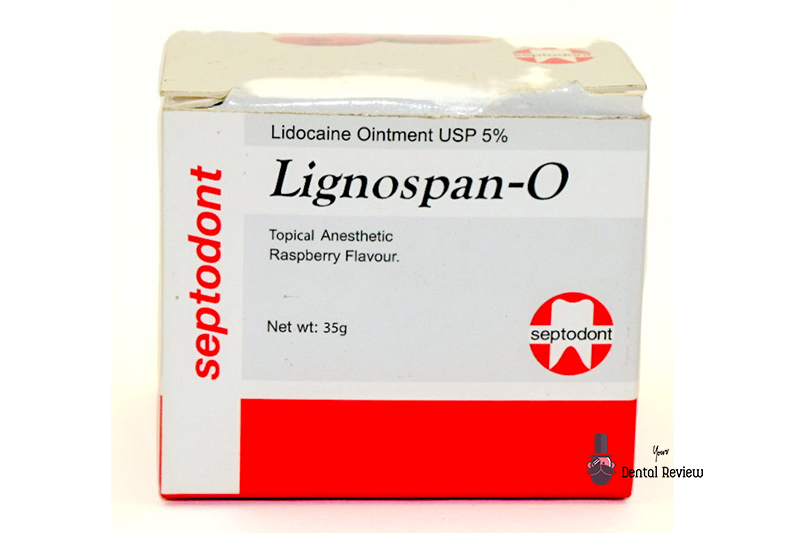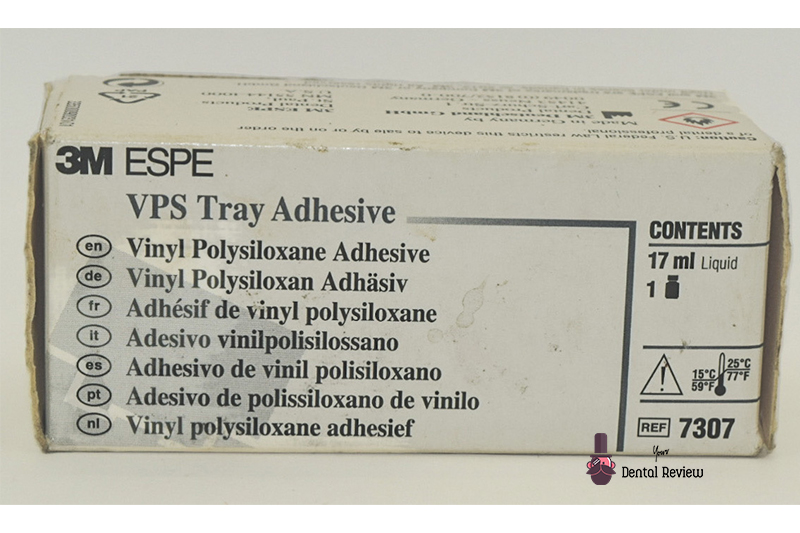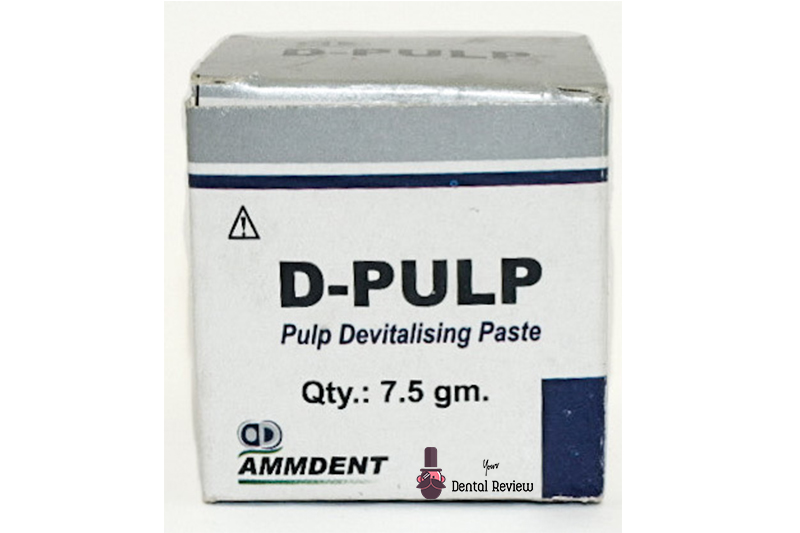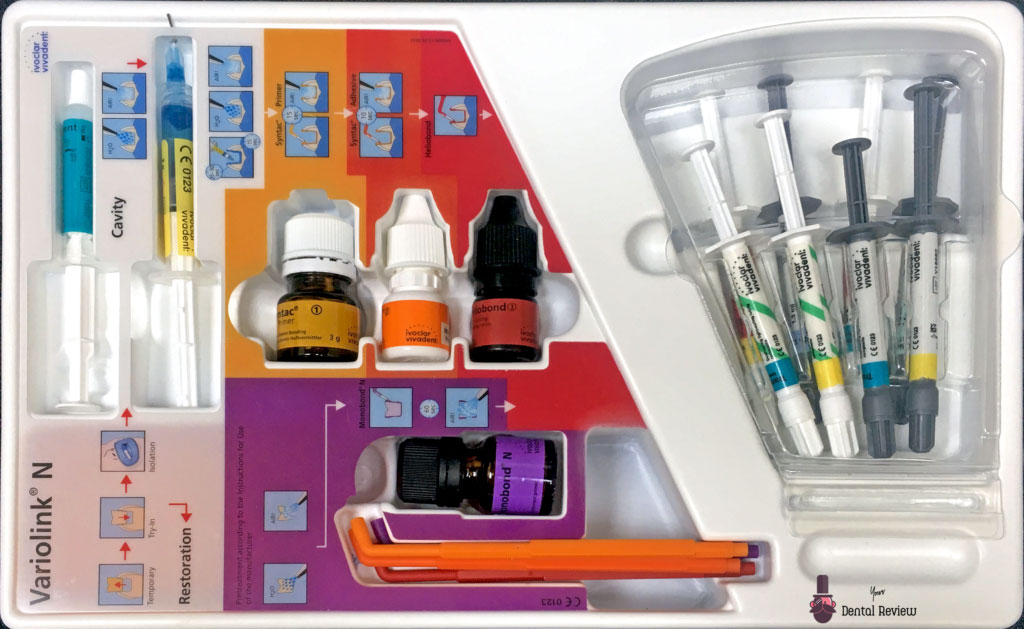
- Variolink N Resin Cement is a Dual cure luting cement
- Available in 2 syringe form
- Base
- Catalyst
- Used to lute
- Glass ceramic, lithium disilicate, composite restorations ( viz, inlays, onlays, veneers, partial crowns, crowns, bridges and endodontic posts)
- Available in 4 different base shades, 2 different catalyst shade. Catalyst is available in 2 viscosities.
Pros:
- Availability of variety in shades and viscosities.
| Base Shades | Catalyst Shades |
| Transparent T | Transparent T |
| A1 | Universal (Yellow) A3 |
| Universal (Yellow) A3 | |
| Bleach XL BL1 |
| Catalyst Viscosities | Used In |
| Low | Partial crowns, crowns |
| High | Inlays/Onlays, Veneers |
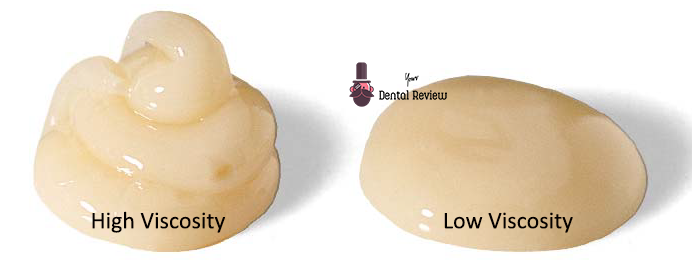
Cons:
- If a dry working field cannot be maintained, Variolink N should not be used.
- Interacts with phenolic substances (like eugenol) and inhibits polymerisation. Hence, mouthwash and eugenol containing temporary cements should not be used to lute temporary crowns.
- Hydrogen peroxide and other oxidative disinfectants interacts with initiator system of Variolink N Primer and impairs the curing process. Hence, they should not be used to disinfect Variolink N.
- Alkaline jet media (e.g. Airflow) impair the effect of adhesive ( Syntax) and should be avoided.
How to use Variolink N Resin Cement
- Clean the prepared tooth with polishing brush and oil free & fluoride free polishing paste.
- Rinse the tooth with water and dry it. Avoid overdrying.
- Try-in the restoration using the given try-in paste. Avoid checking for occlusal contacts to prevent fracture. Proximal contacts can be checked and adjusted for proper seating of the restoration. Adjusted areas should be polished using ceramic polishers.
- After try-in, rinse the restoration with water and dry with with oil free air.
- Isolate the tooth using rubber dam/ cotton rolls and dry the tooth. Don’t overdry.
- Condition the restoration
- For glass ceramic (leucite reinforced and feldspar) and lithium disilicate glass ceramic, etch with 5% hydrofluoric acid for 60 sec and 20 sec respectively. Thoroughly rinse and dry.
- For composite or fibre reinforced composite restorations, sandblast the inner surface according to manufacturers specification. If necessary clean with ultrasonic cleaner for 1 minute. Thoroughly rinse and dry.
- Apply primer, Monobond N or Monobond S on the fitting surface of the restoration with a microbrush and allow to react for 60 secs. Then disperse it with air.
- Apply N-Etch (37% phosphoric acid gel) to the prepared enamel and then flow the etchant onto the prepared dentin. The acid should be left on the enamel for 15–30 seconds and on the dentin for 10–15 seconds. IMPORTANT! Do not etch dentin longer than 15 seconds. Dentin etching is optional and not mandatory if Syntac is used.
- Remove all etchant gel with a vigorous water spray for at least 5 seconds. Excess moisture should be removed until a slightly wet and shimmering dentin surface remains (wet bonding). This can be done with either an air gun, a dry brush, a foam pellet or other lint-free absorbents. Do not overdry the dentin.
- Apply adhesive , Syntax Primer first on the tooth and rub it gently using a brush for 15 seconds on the dentin. Then disperse the primer. Now apply Syntax Adhesive using a new brush and rub it for 10 seconds. Disperse the excess adhesive and dry the tooth.
- Apply heliobond and blow it to a thin layer.
- Mix Variolink N base and catalyst in 1:1 ratio for 10 seconds immediately before application. If using Variolink N LC, which is a pure light curing cement, don’t use for dual cure situations (like, crowns, post etc) or mix with catalyst.
- Mixed Variolink can be placed in the restoration in case of inlays, onlays and crowns. In case of veneers, the mixed Variolink may even be placed on the tooth or on the restoration.
- Seat the restoration immediately. Remove excess cement with a microbrush. Maintain the pressure on the restoration and light cure the central area of the veneer for 3-4 seconds. Further wipe excess cement from the marginal areas but be careful not to remove unset material from the marginal areas thereby leaving gaps.
- Polymerize with light of curing intensity 800mW/cm2 segment by segment, beginning with the proximal margins.
- As with all composites, Variolink N too undergoes surface inhibition and failure of polymerisation. To avoid this, the exposed surface, mainly in the margins, should be covered with glycerine immediately after removal of excess cement. After completion of polymerization, the glycerine can be washed off.
- Check the occlusion and function now and if required correct it. Finish and polish the margins.
| Working time | 3.5 mins |
| Curing time (including working time) | 4 mins |
- Variolink N catalyst should be stored between 2-8o C . Remaining components can be stored at 2-28o C.
Review of Variolink N Resin Cement
Variolink N has been my go to resin cement for veneers, specially as most of the veneers I use are IPS E-max. As both the products (restoration and cement) are produced by the same company, compatibility and ease of use increases.
There are 2 kits available for Variolink N:
- Intro kit
- Professional kit.
I would recommend the professional kit. This kit contains all the components required for luting veneers as mentioned in the ‘How to use’ above, except for 5% hydrofluoric acid. This you can purchase separately. The professional kit also contains all the shades of base and catalyst.
Veneers are mostly made just for esthetic correction and Variolink N works perfectly to complement it. Variolink N has a ‘chameleon effect’ and is able to match the shade of the adjacent teeth. Shade matching is must when the margins are supra gingival. An unmatched cement at the supragingival margins can be a nightmare.
If you are looking for an exclusive cement for your E max veneers, go with Variolink N LC. It is available in Shades of Clear, +1 and +2. It has a film thickness of 9 µm as compared to 15 µm of Variolink N and has a comparable flexural strength of 107 MPa to 110 MPa of Variolink N.
I am asked if Variolink N can be used for cementing veneers? Absolutely it can be used. Point to remember here is, Variolink N LC, as it polymerizes by light, gives you more working time specially if you are luting multiple veneers at one go.

